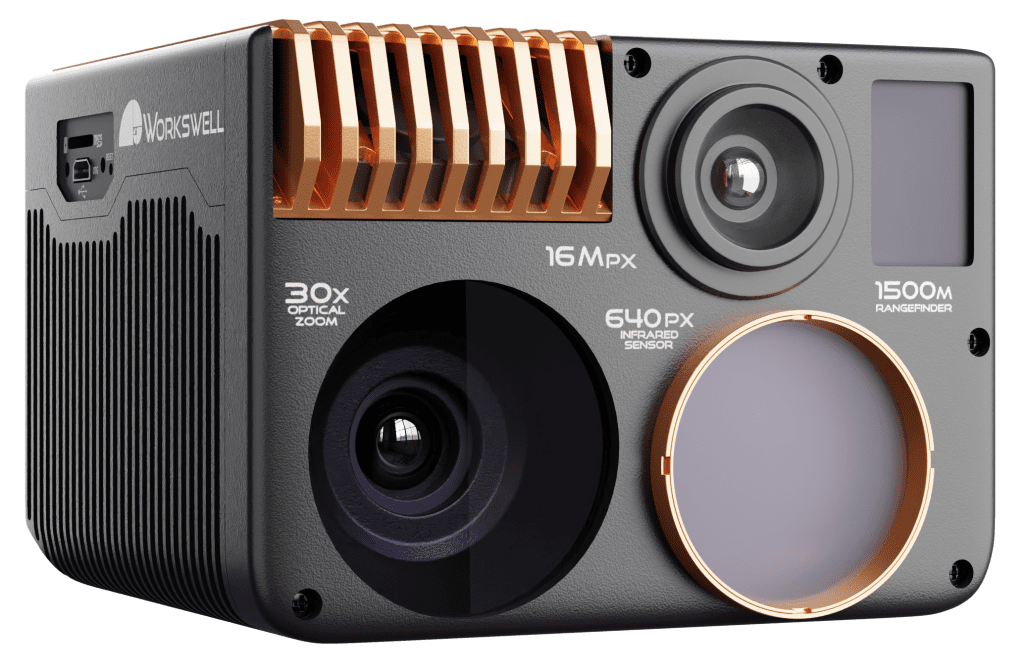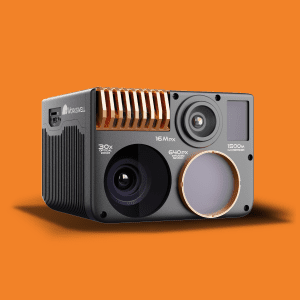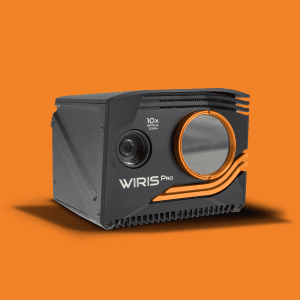Encyclopedia of thermal cameras
Thermal cameras have become an increasingly popular tool in a wide range of industries, from building inspections to surveillance and security. These cameras can detect and display thermal energy emitted by objects, providing valuable insights into temperature variations and potential issues. However, with the growing interest in thermal cameras, there are also many questions surrounding their use and capabilities. In this article, our team of professionals will answer some of the most frequently asked questions about thermal cameras, providing insights into their applications, limitations, and key features. Whether you are a professional in the field or simply curious about thermal cameras, this article will help you gain a better understanding of this innovative technology.
Table of content
- What is a thermal camera used for?
- Is it worth buying a thermal camera?
- How much does a good thermal camera cost?
- Can thermal see through walls?
- How long can a thermal camera see?
- What is the disadvantage of thermal camera?
- How far can a thermal camera go?
- Is night vision infrared vs thermal?
- Can you hide from thermal cameras?
- Can thermal cameras see at night?
- How far can a thermal camera go?
- Can thermal imaging see through clothes?
- How to edit thermal images?
What is a thermal camera used for?
A thermal camera is a type of camera that is designed to detect and capture images based on the thermal radiation emitted by objects. These cameras are often used for a variety of applications, including:
- Industrial Inspections: Thermal cameras can detect temperature variations in industrial equipment and machinery, helping to identify potential malfunctions or inefficiencies.
- Electrical Inspections: Thermal cameras can identify areas of high resistance, detect overheating wires and circuits, and locate loose connections in electrical systems.
- Building Inspections: Thermal cameras can detect areas of energy loss in buildings, such as insulation gaps or leaks around windows and doors.
- Surveillance and Security: Thermal cameras can detect human or animal movement in complete darkness or low light conditions, making them useful for surveillance and security applications.
- Medical Diagnostics: Thermal cameras can detect changes in skin temperature and identify potential health problems, such as inflammation or circulation issues.
Overall, thermal cameras are valuable tools for a wide range of industries and applications that require temperature sensing, detection, or monitoring.
Is it worth buying a thermal camera?
The answer to this question depends on your specific needs and intended use for the thermal camera. Here are some factors to consider when deciding whether a thermal camera is worth purchasing:
- Purpose: What do you plan to use the thermal camera for? If you work in a profession that requires regular temperature measurements, such as building inspections or electrical maintenance, then a thermal camera may be a worthwhile investment. However, if you only need to take occasional temperature measurements or are using the camera for personal use, it may not be worth the expense.
- Cost: Thermal cameras can range in price from a few hundred to several thousand dollars. Consider your budget and the frequency of use to determine whether the cost is worth it.
- Accuracy: Not all thermal cameras are created equal. Some may have better accuracy and resolution than others. If you need highly precise measurements, you may need to invest in a more expensive camera.
- Ease of use: Some thermal cameras can be complicated to operate and require specialized knowledge. Consider whether you or your team have the necessary training to use the camera effectively.
- Other options: Depending on your needs, there may be other options available that could achieve similar results. For example, some smartphones now have built-in thermal cameras or you could use an infrared thermometer instead.
In summary, whether a thermal camera is worth buying depends on your specific needs, budget, and the alternatives available. Consider these factors carefully before making a decision.
How much does a good thermal camera cost?
The cost of a good thermal camera can vary greatly depending on its specifications and features. However, a mid-range thermal camera suitable for general use typically costs between $1,000 and $5,000. More advanced and specialized thermal cameras can cost upwards of $10,000 or more. It’s important to note that while the initial cost of a thermal camera may be significant, it can save money and improve efficiency in the long run by identifying and preventing problems before they become more serious and expensive to fix.
Can thermal see through walls?
Thermal imaging can sometimes “see” through walls, depending on the materials the walls are made of and the technology used for the thermal imaging.
Thermal imaging works by detecting the heat emitted by objects and converting it into a visible image. Some materials, such as wood, drywall, and glass, are relatively transparent to thermal radiation, so thermal cameras may be able to detect heat signatures on the other side of these materials. However, other materials like concrete or metal may block thermal radiation and prevent thermal cameras from seeing through them.
It’s also worth noting that the ability of thermal imaging to see through walls can be affected by other factors, such as the thickness of the wall, the temperature of the objects being imaged, and the sensitivity of the thermal camera being used. In general, thermal imaging is not a foolproof method for seeing through walls and should not be relied upon as the sole means of detecting objects or people on the other side of a barrier.
How long can a thermal camera see?
The range of a thermal camera depends on several factors, including the camera’s specifications, the size and temperature of the object being viewed, and atmospheric conditions.
In general, the range of a thermal camera can vary from a few meters to several kilometers, depending on these factors. Most thermal cameras have a range of a few hundred meters to a few kilometers, depending on the camera’s resolution and sensitivity.
However, it’s important to note that thermal cameras are typically designed to detect heat signatures rather than to provide high-resolution images. So, while a thermal camera may be able to detect the presence of an object at a long range, it may not provide a clear or detailed image of that object.
Did you know, that Enterprise have 1500 m range?
Thermal cameras with a range of 1500 meters offer exceptional long-range detection and imaging capabilities, making them well-suited for various specialized applications in industries such as security, defense, industrial inspections, and wildlife research.
With their ability to capture thermal radiation and convert it into visible images, these cameras provide valuable insights and enhance situational awareness, making them an invaluable tool for many enterprises.

What is the disadvantage of thermal camera?
While thermal cameras are incredibly useful in many applications, there are also some disadvantages to using them, including:
- Limited Detail: Thermal cameras do not provide the same level of detail as traditional cameras, especially when it comes to facial recognition and other identification purposes.
- Limited Range: The range of a thermal camera is limited, typically only detecting temperatures within a few hundred feet. This can be a disadvantage when monitoring large areas.
- Limited Accuracy: The accuracy of thermal cameras can be affected by environmental factors such as humidity, wind, and rain.
- Cost: Thermal cameras can be expensive compared to other types of cameras, which can be a barrier to adoption for some organizations.
- Privacy Concerns: Thermal cameras can be seen as an invasion of privacy in some situations, especially if they are used for surveillance purposes.
- Limited Use in Daytime: Thermal cameras are less effective during the daytime when there is ample sunlight, as the temperature difference between objects and the environment is reduced.
Overall, while thermal cameras have many benefits, it’s important to understand their limitations and consider alternative technologies in certain situations.
How far can a thermal camera go?
The distance that a thermal camera can detect objects depends on various factors such as the camera’s resolution, the sensitivity of its detector, the ambient temperature, and the size and temperature of the object being detected.
Generally, most thermal cameras have a range of several hundred meters. However, the detection range can be significantly reduced in conditions of high humidity, fog, or heavy rain, as these conditions can attenuate the thermal radiation emitted by objects and reduce the contrast between the object and its background.
Moreover, the range of the thermal camera can be extended by using a high-quality lens, increasing the camera’s sensitivity, and reducing the noise in the images. It is also important to note that the resolution of the thermal camera can also affect the detection range, as higher resolutions can provide better image detail and enable the detection of smaller objects at longer distances.
Overall, the detection range of a thermal camera can vary depending on several factors and ranges between a few meters to several kilometers in ideal conditions.
Is night vision infrared vs thermal?
Night vision technology can include both infrared and thermal imaging, although they work in slightly different ways.
Infrared night vision relies on detecting the heat emitted by objects and converts it into an image that can be seen by the human eye. This is also known as “passive” infrared night vision because it does not emit any light of its own. Instead, it relies on the heat emitted by the object to create an image.
Thermal imaging, on the other hand, detects the temperature differences between objects and creates an image based on those differences. This is also known as “active” thermal imaging because it emits its own infrared radiation to create an image.
Both infrared and thermal imaging can be used for night vision purposes, but they have different strengths and weaknesses depending on the situation. In general, thermal imaging is better for detecting objects that are further away, while infrared is better for detecting objects that are closer.
Can you hide from thermal cameras?
Thermal cameras detect infrared radiation, which is emitted by objects based on their temperature. Therefore, if you can significantly reduce your body’s heat signature or block it with materials that do not emit heat, you can potentially hide from thermal cameras. However, this can be quite difficult, and it depends on several factors such as the sensitivity of the camera, the ambient temperature, and the type of material you use to hide.
Some effective ways to reduce your heat signature and potentially hide from thermal cameras include:
- Wearing clothing made of materials that do not retain heat, such as cotton or silk.
- Wearing clothing that is insulated with materials that are good at blocking heat, such as Kevlar.
- Using reflective materials, such as mylar, to reflect the ambient temperature away from your body.
- Cooling down your body temperature by immersing yourself in cold water or using cooling packs.
- Using camouflage techniques, such as wearing clothing that blends in with the environment or using natural materials to cover yourself.
It’s worth noting that thermal cameras can still detect some amount of heat, even if it’s significantly reduced. Therefore, it’s difficult to guarantee complete invisibility from thermal cameras. Additionally, some thermal cameras can also detect movement, which means that staying completely still may be necessary to avoid detection.
Can thermal cameras see at night?
Can thermal cameras see at night?
Yes, thermal cameras can see at night. Unlike visible light cameras, thermal cameras detect radiation in the infrared spectrum, which is emitted by all objects with a temperature above absolute zero. This means that thermal cameras can detect heat signatures even in complete darkness or through smoke and fog.
Thermal cameras are commonly used in various applications, including surveillance, search and rescue, firefighting, and industrial inspections. They can detect temperature differences as small as 0.1°C and create images based on the heat signature of objects, allowing them to identify people, animals, or objects that emit heat, even in the absence of visible light.
Can thermal imaging see through clothes?
Thermal imaging technology can detect differences in temperature and can be used to see through some types of clothing, but it cannot produce a detailed image like an X-ray or other medical imaging technology.
Thermal imaging cameras detect and measure the infrared radiation emitted by objects, including human bodies. Different materials and objects emit different levels of radiation, which can be used to create an image of the scene. Some materials, such as cotton or silk, are more transparent to infrared radiation than others, such as wool or polyester, and therefore may be more easily penetrated by thermal imaging.
However, it is important to note that thermal imaging cannot see through all types of clothing, particularly those that are thicker or have multiple layers. Additionally, certain factors such as the ambient temperature, the distance between the camera and the person, and the angle of the camera can also affect the accuracy of the image produced.
It is also worth mentioning that using thermal imaging to see through clothing without consent is illegal and a violation of privacy.
How to edit thermal images?
To edit thermal images in software, you will need to use a specialized image editing software that supports thermal imaging data. Here are some steps you can follow:
- Choose a software: First, choose a software that supports thermal imaging data.
- Open the thermal image: Once you have selected your software, open the thermal image you want to edit.
- Adjust the temperature scale: Most thermal imaging software allows you to adjust the temperature scale to make it easier to interpret the data. You can adjust the scale to highlight specific temperature ranges, or to make subtle temperature differences more visible.
- Adjust the contrast and brightness: You can adjust the contrast and brightness of the image to enhance its overall appearance and make it easier to see details.
- Add annotations: You can add text, arrows, and other annotations to the thermal image to highlight specific features or provide additional information.
- Save your edited image: Once you have made all the necessary edits, save your edited image in a format that is compatible with your intended use. Some common file formats for thermal images include JPEG, PNG, and TIFF.
It’s important to note that thermal images are sensitive to temperature changes and need to be handled carefully to avoid misinterpretation. Make sure to follow the guidelines and instructions provided by the software and consult with a thermal imaging expert if you have any questions.
Do you want software for free? Try Thermolab!
ThermoLab's user interface is intuitive and easy to use, making it accessible to professionals and researchers with varying levels of experience in thermodynamics.
The software also includes a range of visualization tools, such as 3D models and charts, which help users to understand and interpret their results.


